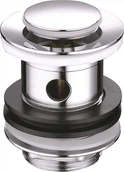Hey there! I'm a supplier of Basin Waste, and today I wanna chat about a pretty interesting topic: Can Basin Waste be used in soil improvement?
First off, let's talk about what Basin Waste is. Basin Waste comes in all sorts of types. There's the Click Clack Sink Waste, which is super handy for controlling the water flow in sinks. Then we have the Ceramic Basin Waste, known for its durability and aesthetic appeal. And don't forget the Flip Waste Plug, a simple yet effective way to stop and start the water in your basin.
Now, when we think about using Basin Waste for soil improvement, it might seem a bit far - fetched at first. But hear me out. Most of the Basin Waste we deal with is made from materials like plastic, metal, or ceramic. Plastic Basin Waste, for example, doesn't have any direct nutritional value for the soil. It's non - biodegradable, which means it won't break down into nutrients that plants can use. But in some cases, small pieces of plastic can act as a sort of soil conditioner in terms of soil structure. They can create small air pockets in the soil, improving aeration. This is especially important for plants that need well - aerated soil to grow properly.
Metal Basin Waste is a different story. Some metals, like iron, can be beneficial for the soil. Iron is an essential micronutrient for plants. It plays a crucial role in photosynthesis, helping plants to produce chlorophyll. However, not all metals are good for the soil. Metals like lead or mercury are toxic. If there's any contamination of these heavy metals in the Basin Waste, it can be extremely harmful to the soil and the plants growing in it. So, if you're thinking of using metal Basin Waste in soil improvement, you need to make sure it's free from these harmful metals.
Ceramic Basin Waste is generally inert. It doesn't release any significant nutrients into the soil. But similar to plastic, crushed ceramic pieces can improve soil drainage. If you have heavy clay soil that tends to hold water for too long, adding some crushed ceramic Basin Waste can help the water drain away more quickly. This prevents waterlogging, which can lead to root rot in plants.
Let's look at some real - world examples. There have been small - scale experiments where gardeners have mixed crushed ceramic Basin Waste with their potting soil. They've noticed that the plants in these pots grow better, mainly because of the improved drainage. In some urban gardening projects, small pieces of plastic Basin Waste have been added to raised beds to improve soil aeration. The results have been quite promising, with plants showing better growth and fewer signs of stress.


However, there are also some concerns. When using Basin Waste in soil improvement, we need to be careful about the size of the pieces. If the pieces are too large, they can actually impede root growth. For example, a big chunk of plastic or ceramic can block the roots from spreading out in the soil. Also, as I mentioned earlier, the potential for contamination is a big issue. We need to ensure that the Basin Waste we're using is clean and free from any harmful substances.
Another aspect to consider is the long - term effects. We don't have a lot of long - term studies on the use of Basin Waste in soil improvement. While the short - term benefits seem positive in some cases, we don't know what will happen to the soil and the plants over a period of 10, 20, or more years. There could be unforeseen consequences, such as the slow release of chemicals from the plastic or metal Basin Waste into the soil.
In terms of the environmental impact, using Basin Waste in soil improvement can be a form of recycling. Instead of sending all this waste to landfills, we're finding a new use for it. This reduces the amount of waste that ends up in landfills, which is a good thing for the environment. But at the same time, we need to make sure that this recycling method doesn't cause more harm than good.
So, can Basin Waste be used in soil improvement? The answer is yes, but with caution. It can offer some benefits in terms of soil structure, aeration, and drainage. But we need to carefully select the type of Basin Waste, ensure it's clean, and monitor the effects on the soil and plants over time.
If you're interested in trying out using Basin Waste in your gardening or soil improvement projects, I'd love to hear from you. As a Basin Waste supplier, I can provide you with different types of Basin Waste that are suitable for this purpose. Whether you need Click Clack Sink Waste, Ceramic Basin Waste, or Flip Waste Plug, I've got you covered. Let's have a chat and see how we can work together to make your soil better and your plants thrive.
References:
- Small - scale gardening experiments from local gardening communities
- Basic knowledge of plant nutrition and soil science textbooks





